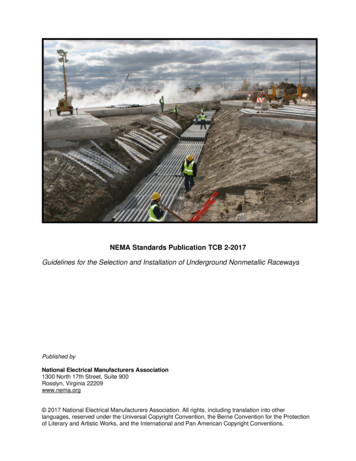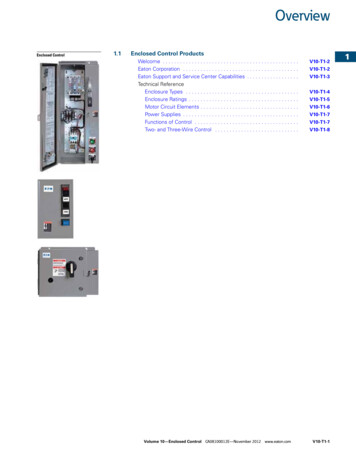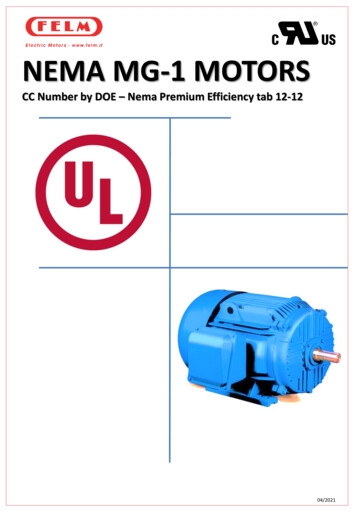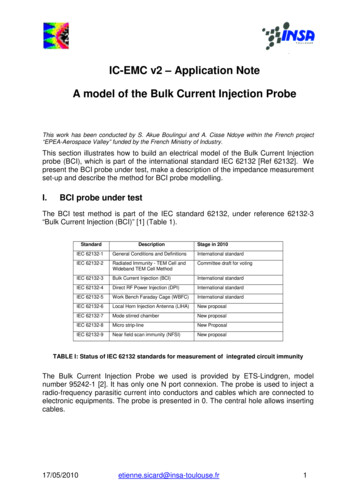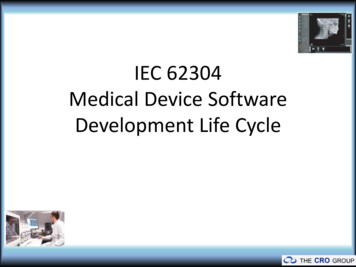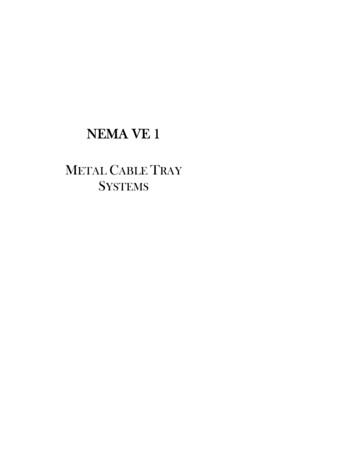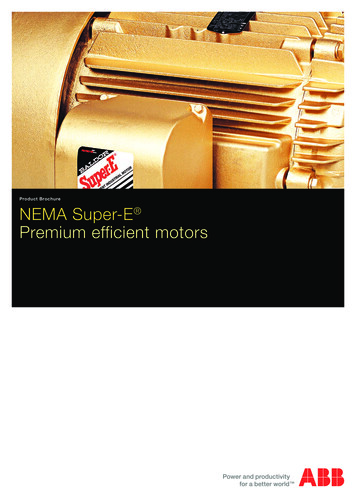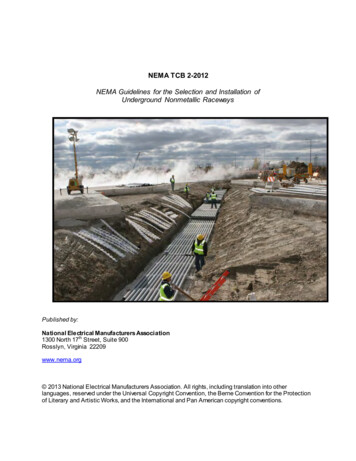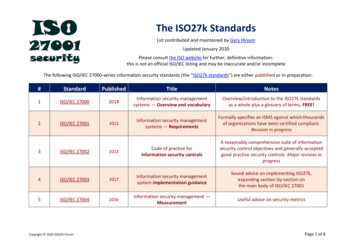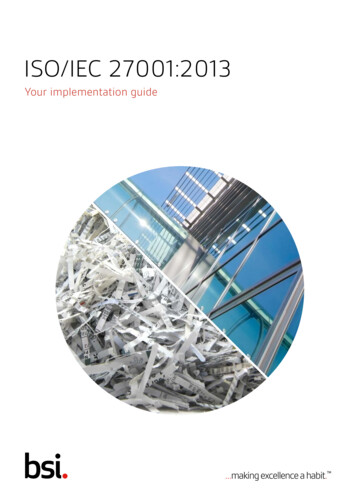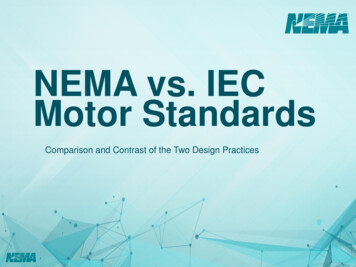
Transcription
NEMA vs. IECMotor StandardsComparison and Contrast of the Two Design Practices
NEMA Standards vs. IECStandards Overview/Objectives:Voltage and Frequencyo Service Factory / Duty Typeo Insulation Classeso Efficiency Measurementso Altitude and Ambient Temperatureo Frame Size Designationso Construction Comparisonso
Voltage, FrequencyNominal Voltages@ 50 HzNEMAIEC220230230/400380500*400/6901000Nominal Voltages@ 60 60575600
Voltage, FrequencyVoltageFrequencyNEMA /- 10%IEC, zone /- 5%A /- 5% /- 2%IEC, zone /- 10%B 3% / -5%NEMA/IEC Allowable VoltageandFrequency Variations for Motors
Voltage, FrequencyZone BZone ANEMA
Service Factor/Duty Type Service Factor NEMA MG 1 definition Example: 400 HP with 1.15 SF can be runcontinuously at 400 x 1.15 460 HP May be employed for several reasonsUncertainty in the load HP requiremento Intermittent overloadso Unbalanced supply voltageso Comfort factor for usero Motor runs hotter – reduced insulation/bearinglife
Service Factor/Duty Type IEC - does not recognize the use of servicefactor IEC - specifies a “Duty Type” for each motordesign Purchaser of machine must specify dutyNumericallyo As a time sequence grapho By selecting a predefined duty (S1-S10)o
Service Factor/Duty uousShort timeIntermittent periodicIntermittent periodic with startingIntermittent periodic with electric brakingContinuous operating periodicContinuous operating periodic with electric brakingCont. operating with related load/speed changesDuty with non-periodic load and speed variationsDuty with discrete constant loads and speeds
Insulation Classes NEMA identifies four insulation classes: A, B, F & H Temperature rise by resistance limits for low voltage,random wound shown – based on 40 C ambientNote1Class A(105 C)60Class B(130 C)80Class F(155 C)105Class H(180 C)12527090115--3658511013046585110--Note 1: Motors with a 1.0 SF, other than in notes 3 & 4Note 2: All motors with a 1.15 SF or higherNote 3: Totally enclosed non-ventilated motors with a 1.0 SFNote 4: Motors with encapsulated windings and with a 1.0 SF
Insulation Classes IEC identifies many thermal classes Maximum allowable total temperature ( C)IEC Thermal signationYAEBFHNR-
Efficiency –Measurement Harmonization Under the old IEC standard, 0.5% of inputpower at rated load was used to calculatethe additional load (stray) losses New standard uses same method as IEEE112 method BoStray losses “indirectly” measured This method is employed by majority ofmotor manufacturers
Efficiency – NEMA Standard MG1 Nominal efficiency values in defined in Part 12 Nameplate efficiency selected from Table 12-10 average efficiency of a large populationof the same design For an individual motor: efficiency the minimumvalue associated with the nominal value in Table12-10
Efficiency - IEC IEC defines International Energy-efficiencyclasses(IE Codes) in IEC Standard 60034-30 IEC motor nameplate efficiency is the ratedefficiency assigned by the manufacturer For a particular IE code, the rated efficiency mustnot be less than the value given in 60034-30 forthat rating For IEC motors, the rated efficiency and IE codeshall be marked on the nameplate (IE2-84,0%)
Efficiency – NEMA/IECPortion of NEMA MG1 Table 12-10EFFICIENCY 497.196.896.596.295.895.4Minimum Efficiency Basedon 20% Loss 95.495.094.5
Efficiency – NEMA/IECPortion of NEMA Table 12-10EFFICIENCY LEVELSNominal Minimum Efficiency BasedEfficiency on 20% Loss 96.1%NameplateEfficiencyNEMAIEC95.8%96.1%IEC nameplate efficiencywould be 0.3% higher thanNEMA motor of samedesign
Efficiency - Harmonization IEC IE2 and IE3 levels for 60 Hz motors wereadopted directly from MG 1 Tables 12-11 and 1212NEMA LevelIEC Level-IE1Energy EfficientIE2Premium EfficiencyIE3Efficiency Levels for 60 Hz MotorDesigns NEMA 50 Hz efficiency values found in Table 1214 were derived directly from IEC 60034-30
Altitude/Ambient Interrelated and considered together 3300’ (1000 m) maximum altitude withoutneed for compensation for both NEMA &IEC 40 C maximum allowable ambient withoutcompensation for both NEMA & IEC
Altitude - NEMA Above 3300’, NEMA – two optionsReduction in ambiento Reduction in permissible rise at sea levelTRSL TRA [1-(ALT-3300)/33000]Where:TRSL temperature rise limit in degrees C when testedat sea levelTRA standard permissible temperature rise limit at sealevel for the insulation classALT altitude above sea level in feet at which machine isto be operatedo
Altitude - NEMAReduction in ambient required by NEMAat high altitude to avoid reduction inpermissible temperature riseMaximum Altitude,Feet (Meters)3300 (1000)6600 (2000)9900 (3000)AmbientTemperature ( C)403020
Altitude - IEC Above 3300 ft. (1000 meters), IECo Between 1000 and 4000 meters: assumes ambientreduction will compensate for higher temperatureriseAltitude, Meters1000200030004000o ForThermal Class130 (B)155 (F)180(H)Ambient Temperature ( C)4040403230282419151693altitudes above 4000 meters, the IEC says thetemperature rise shall be adjusted “by agreement”
Ambient For ambient temperaturesabove 40 C:oNEMA specifies thetemperature rise be reducedby the amount over 40 CoIEC specifies the temperaturerise be reduced by theamount over 40 C (40-60 Conly)oAbove 60 C, IEC specifiesthe temperature rise beadjusted “by agreement”
Ambient (0 C A 40 C) For ambient temperatures between 0 &40 C:– Both NEMA and IEC use an equation todetermine the allowable increase in permissibletemperature rise– There are slight differences to be aware of
Ambient (0 C A 40 C)NEMA– For in ambient of 5 C, add to allowable rise– For in ambient 5 C use the following formula:Increase in Rise (40 C-marked ambient)(1[reference temperature – (40 C temperature riselimit)]/80 C)Where reference temperature is from following table:Class of Insulation SystemABFHSF 1.15105130155180SF 1.15115140165190
Ambient (0 C A 40 C)IEC For any ambient between 0 & 40 C, use the followingformula:Increase in Rise (40 C-marked ambient)(1-[thermal class– (40 C temperature rise limit)]/80 C)—IEC does not take service factor into account, as service factor isnot recognized by the IEC
Frame Size Designations NEMA MG 1 assigns a frame size based onenclosure, HP and rpm for 60 Hz operation IEC does not associate any specific output powerand speed to a specific frame sizeCENELEC harmonization document HD231 doeso This document covers totally enclosed squirrel cagemotors at 50 hz, 56 to 315M frames, up to 132 kWo
Frame Size DesignationsNEMAShaftFrame Height(in)424856 17.0431.800ShaftFrame 250280315355400450500
Frame Size Designations IEC measurement labels tend to bemore logically definedLength: NEMA C, IEC LShaft height: NEMA D, IEC HShaft diameter: NEMA U, IEC D IEC in mm, NEMA in inches Many dimensions are very close NEMA output shafts tend to belonger Shaft heights, foot spacing and shaftdiameters generally within 3 or 4mm
Merging of Standards IEC enclosure (IP) & cooling (IC) codes are included in NEMA MG 1 NEC incorporates IEC hazardous area zone classifications IEC 60034-2-1 contains a test method essentially equivalent to IEEE 112(method B) and CSA 390-10 NEMA 50 Hz efficiency values found in Table 12-14 were derived directlyfrom IEC 60034-30 IEC IE2 and IE3 levels for 60 Hz motors were adopted directly from MG-1Tables 12-11 and 12-12North American participation in global standards writing is becoming morewidespread – it is reasonable to expect further infusion of IEC specificationsas U.S. manufacturers expand into global markets
IEEE 841 Construction Norms & ExpectationsElectrical Features841 NEMAService ConditionService FactorCoolingDivision II Normal1.0 (1.15 is normal)TENV & TEFCEfficiency StandardConnectionStarting MethodNominal per NEMA MG1, table 12-12 withminimums from 12-103-lead with flying leadsLine startInverter Capable?Yes
IEEE 841 Construction Norms & ExpectationsMechanicalFeatures841 NEMAStd. IECConduit BoxCenter- side mount,rotatable in 90 increments, diagonallysplit lidDrive-end top mount castto frame with flat coverShaft SealNon-contact labyrinth sealboth endsContact seal on drive endof shaftLevel of ProtectionIP55 or IP56SameBearings RetainersCast iron both endsUsually on drive end onlyGrease ProvisionsExtended greasers withrelief each endGrease provisionsThrust LoadingOptional thrust bearingsfor pumpsNot normal in IEC motorsas European pumpsusually handle the thrustload
Typical IEEE-841 Motor Construction3 Flying leadsSide mountedconduit boxRotatinglabyrinth sealCast iron frame ,endplates andBearing retainersCast iron fan cover
IEEE 841 Construction Norms & ExpectationsMotortestingNEMAMeasurement of windingresistanceIEEE 841TestsNo-load readings of current,power and nominal speed atrated voltage and frequencyMechanical vibration check – 2perpendicular on radial and oneon axial planeHigh potential test
Conclusion A wide variety of electric motors are available ineither IEC or NEMA design An understanding of these differences andsimilarities of the design standards will help youselect the correct design requirements for a newinstallation or field replacement Once you can detail the design and performancerequirements for your application, you can identifyacceptable motors to choose from whether they areNEMA design or IEC design34
NEMA MG 1 assigns a frame size based on enclosure, HP and rpm for 60 Hz operation IEC does not associate any specific output power and speed to a specific frame size o CENELEC harmonization document HD231 does o This document covers totally enclosed squirrel cage motors at 50 hz, 56 to 315M frames, up to 132 kW . Frame Size Designations NEMA IEC Frame Shaft Height (in) Shaft
